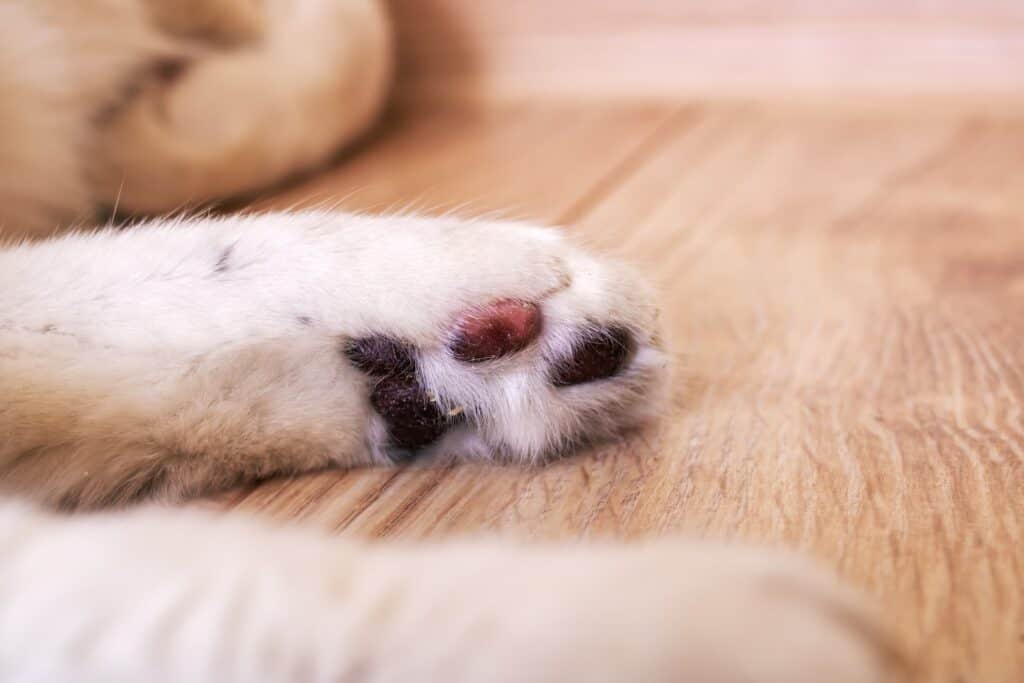This post contains affiliate links.
If you’re a Shiba Inu owner, you may have noticed that your furry friend’s paw pads are discolored. This is a common issue that various factors can cause many Shiba Inus to face.

What Color Should A Shiba Inu’s Paw Pads Be?
When it comes to Shiba Inu paw pads, the ideal color is black or dark brown. While there may be variations in color depending on the individual dog’s coat color, a healthy Shiba Inu’s paw pads should be primarily black or dark brown.
It’s important to note that some Shiba Inus may have discolored paw pads due to genetics or medical conditions. For example, some Shiba Inus may have pink or white paw pads due to a condition called “snow nose” or “winter nose,” which causes a temporary loss of pigmentation in the nose and paw pads during colder months.
However, suppose your Shiba Inu’s paw pads are consistently discolored or show signs of irritation or infection. In that case, it’s important to consult with your veterinarian to rule out any underlying health issues.
Common Causes For Discolored Paw Pads
If you notice that your Shiba Inu’s paw pads are different colors, it could indicate an underlying health issue. Here are some common causes of discolored paw pads in dogs:
Allergies
Allergies can cause inflammation and discoloration of your dog’s paw pads. Common allergens include pollen, dust mites, and certain foods. Your vet can perform tests to determine the cause of your dog’s allergies and recommend appropriate treatment.
Fungal and Bacterial Infections
Fungal and bacterial infections can also cause discolored paw pads. These infections can be caused by environmental factors or poor hygiene. Your vet can perform tests to determine the type of infection and prescribe the appropriate treatment.
Nail Issues
Ingrown nails, torn nails, and other nail issues can cause discoloration of the paw pads. If you notice your dog favoring one paw or limping, it could be a sign of a nail issue.
Burns and Blisters
Burns and blisters can cause discoloration and irritation of the paw pads. Hot pavement, chemicals, or other environmental factors can cause these injuries.
Dry and Cracked Paw Pads
Dry and cracked paw pads can cause discoloration and discomfort for your dog. This can be caused by exposure to harsh chemicals or environmental factors. Your vet can recommend treatments to soothe and moisturize your dog’s paw pads.
Cuts and Abrasions
Cuts and abrasions can cause discoloration and infection of the paw pads. These injuries can be caused by sharp objects or rough terrain. If you notice your dog favoring one paw or limping, it could be a sign of a cut or abrasion.
Parasites
Parasites such as fleas and ticks can cause discoloration and irritation of the paw pads. These parasites can also transmit diseases to your dog. Regular flea and tick prevention is essential to protect your dog’s health.
Cysts and Growths
Cysts and growths can cause discoloration and discomfort for your dog. Genetic factors or environmental factors can cause these. Your vet can perform tests to determine the type of growth and recommend appropriate treatment.
If you notice any discoloration or irritation of your Shiba Inu’s paw pads, it’s important to consult with your vet. They can determine the underlying cause and recommend appropriate treatment to keep your dog healthy and happy.
Why Are My Shiba’s Paw Pads White?
If you’ve noticed that your Shiba Inu’s paw pads are white, you might be wondering what’s causing this discoloration. There are a few possible reasons why your dog’s paw pads might be white, including:
1) Genetics
Some Shiba Inus are born with pink paw pads due to their genetics. This is especially common in cream-colored Shibas, whose paw pads often match their lighter coat color.
2) Age
As dogs age, their paw pads can become lighter in color. This is because the skin on their paw pads becomes thinner and less pigmented over time.
3) Environmental factors
Exposure to certain environmental factors can cause your Shiba’s paw pads to become discolored. For example, walking on hot pavement or sand can cause the skin on their paw pads to dry out and become lighter in color. Similarly, exposure to certain chemicals or irritants can also cause discoloration.
4) Health issues
In some cases, white paw pads may indicate an underlying health issue. For example, autoimmune disorders, allergies, and infections can all cause changes in skin pigmentation.
If you’re concerned about your Shiba Inu’s paw pads, consulting with your veterinarian is always a good idea. They can help determine the underlying cause of the discoloration and recommend appropriate treatment options.
How To Treat Your Shiba’s Discolored Paw Pads
If you notice that your Shiba Inu’s paw pads are discolored, it’s important to prevent further damage. Here are some tips on how to treat your Shiba’s discolored paw pads:
1) Visit Your Vet
The first step in treating your Shiba’s discolored paw pads is to take them to the vet. Your veterinarian will examine your Shiba’s paws and determine the cause of the discoloration. Depending on the cause, your vet may prescribe medication or recommend an anti-inflammatory cream to help reduce any swelling or pain.
2) Keep Your Shiba’s Paws Clean and Hydrated
To help your Shiba’s paw pads heal, it’s important to keep them clean and hydrated. You can do this by wiping your Shiba’s paws with a damp cloth or using a paw-cleaning solution. You can also apply petroleum jelly to your Shiba’s paw pads to help keep them moisturized.
3) Provide Pain Relief
If your Shiba is experiencing pain or discomfort, it’s important to provide them with pain relief. Your vet may prescribe medication to help manage any pain. You can also use cold compresses or soak your Shiba’s paws in cool water to help reduce any discomfort.
4) Follow Your Vet’s Recommendations
It’s important to follow your vet’s recommendations for treating your Shiba’s discolored paw pads. This may include applying medication or cream to your Shiba’s paw pads, keeping them clean and hydrated, and providing pain relief as needed. Following your vet’s recommendations can help ensure your Shiba’s paw pads heal properly.
These steps can help treat your Shiba’s discolored paw pads and prevent further damage. Remember to always consult with your veterinarian before starting any treatment regimen for your pet.
Summary
If you own a Shiba Inu, you may have noticed that their paw pads have become discolored. This condition is common and can be caused by various factors.
Various factors, including allergies, infections, and trauma, can cause discolored paw pads. If your Shiba Inu is limping or showing signs of pain, it is important to seek veterinary care immediately. Your veterinarian will be able to diagnose the underlying cause and provide appropriate treatment.
Preventing discolored paw pads involves proper care and maintenance. Keep your Shiba Inu’s paws clean and dry, and avoid walking them on hot pavement or rough terrain. Regularly check their paws for signs of injury or infection, and trim their nails regularly to prevent overgrowth.
The prognosis is generally reasonable if your Shiba Inu develops discolored paw pads. With proper treatment and care, most dogs recover fully and are able to resume their normal activities. However, seeking veterinary care as soon as possible is important to prevent any potential complications.
Frequently Asked Questions
What Does Pododermatitis Look Like In Dogs?
Pododermatitis is a skin condition that affects a dog’s paw pads. It can cause redness, swelling, and skin thickening on the paw pads. In severe cases, the paw pads may become ulcerated and painful. Dogs with pododermatitis may also lick their paw pads excessively or limp.
Why Does My Dog’s Paw Pad Look Weird?
There are several reasons why your dog’s paw pad may look weird. One common cause is hyperkeratosis, a thickening of the skin on the paw pads. Genetics, environmental factors, or an underlying medical condition can cause this. Other causes of discolored paw pads include chilblains, caused by exposure to cold temperatures, and hyperpigmentation, which is an increase in pigment in the skin.
How Did My Dog Get Hyperkeratosis?
Hyperkeratosis is a genetic condition affecting certain dog breeds, including Shiba Inus. Environmental factors, such as exposure to rough surfaces or chemicals, can also cause it. Hyperkeratosis can sometimes indicate an underlying medical condition, such as a hormonal imbalance or an immune system disorder.
What Are Dog Paw Chilblains?
Dog paw chilblains, also known as pernio or perniosis, are a type of frostbite that affects the paw pads. They are caused by exposure to cold temperatures and can cause redness, swelling, and pain. Dogs with chilblains may also lick their paw pads excessively or limp.
What Is Hyperpigmentation In Dogs?
Hyperpigmentation is an increase in the production of pigment in the skin. It can cause dark patches or spots on a dog’s skin, including the paw pads. Genetics, hormonal imbalances, or an underlying medical condition can cause hyperpigmentation.
If you notice any changes in your dog’s paw pads, it’s essential to consult with a veterinarian. They can help diagnose the underlying cause and recommend appropriate treatment. You can also use an “Ask a Vet” tool for expert advice.
